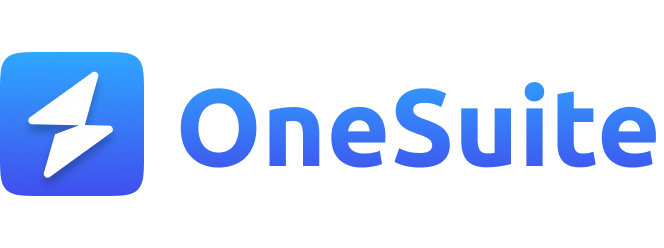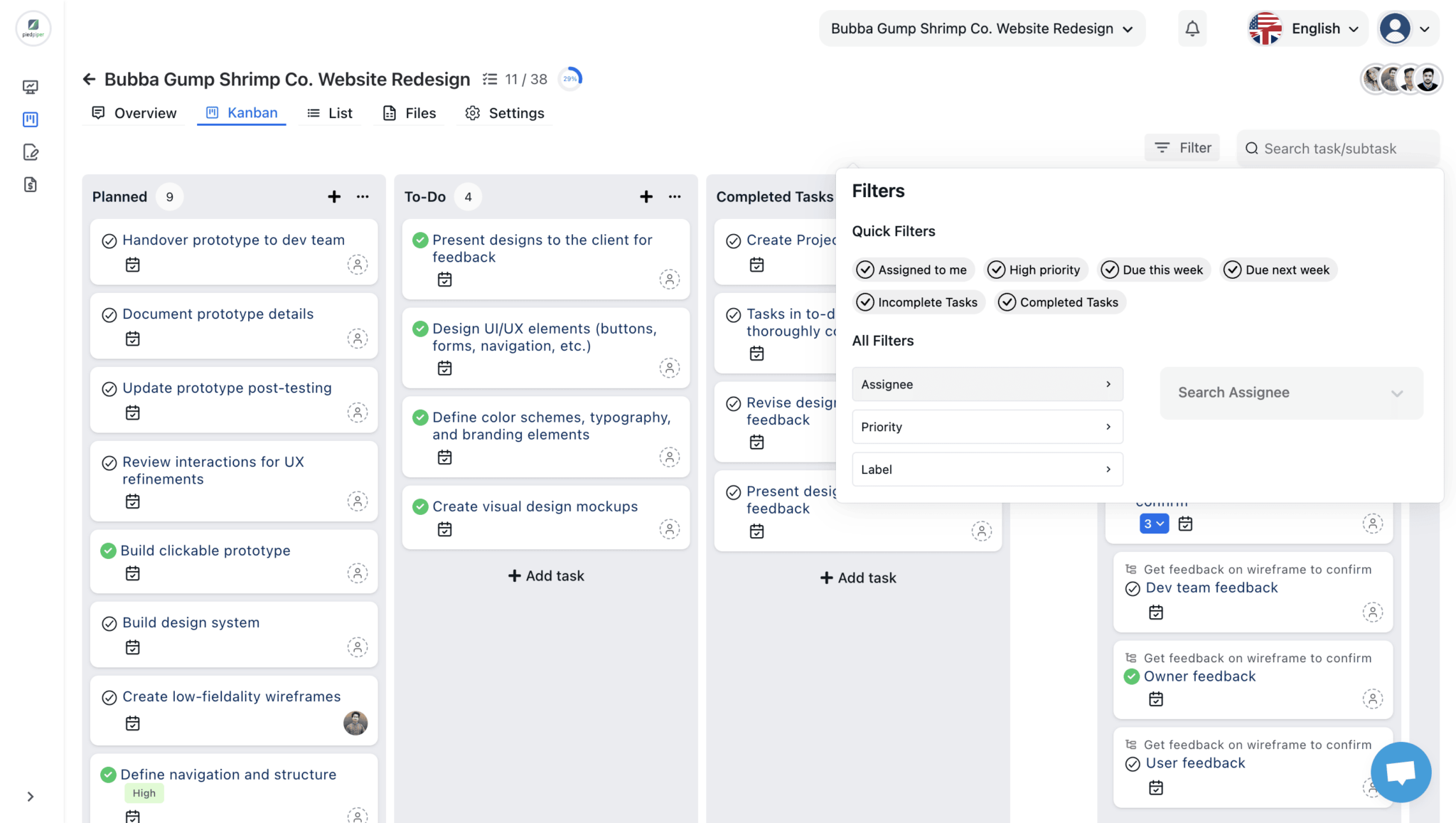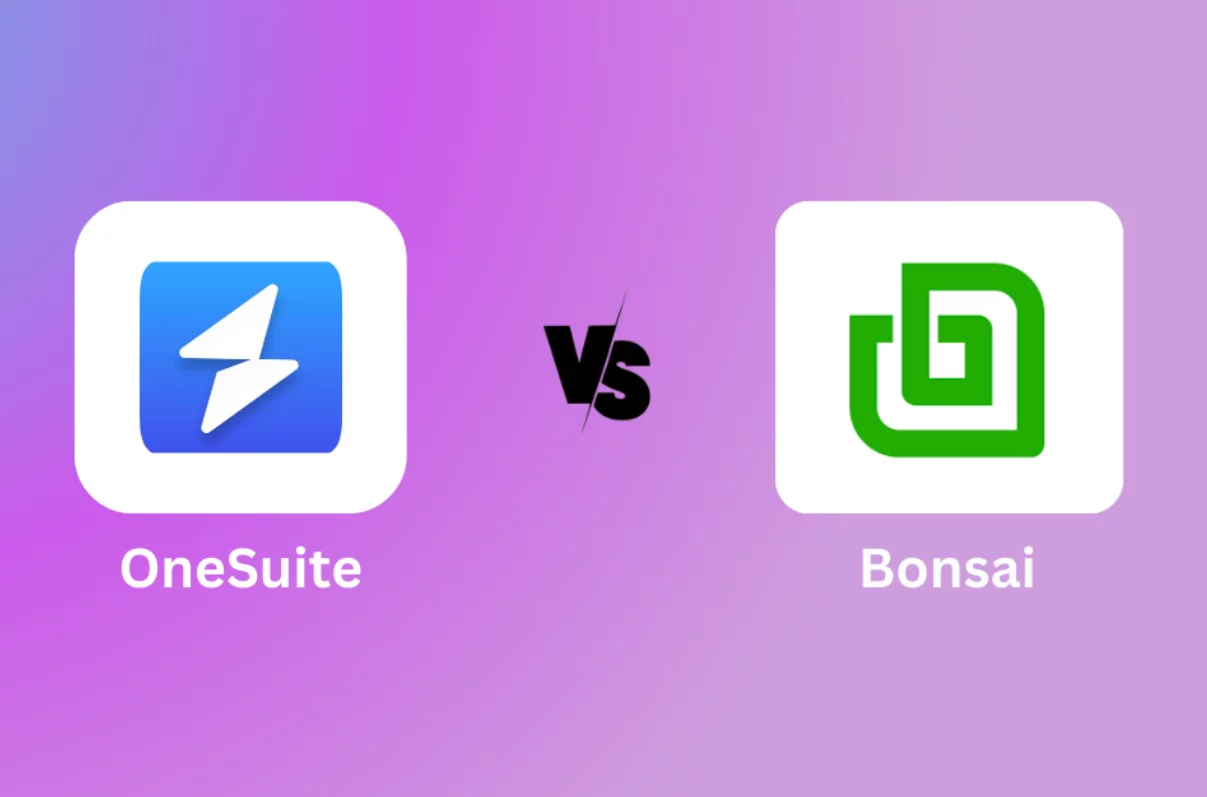
So, you’re on the hunt for the perfect project management tool?
OneSuite and Bonsai are 2 big names that probably caught your eye. Both have many features that can help your team stay on top of tasks and work more efficiently.
But when it comes down to the nitty-gritty, there are some key differences to consider.
This guide will help you compare OneSuite and Bonsai, examining their key features, strengths, and potential drawbacks to decide which suits your needs best.
By the end, you’ll have a clear idea of which one suits your business best.
At a Glance
- OneSuite is best for managing a digital agency.
- Bonsai is best for small business owners.
- OneSuite pricing Starts at $59/month for 10 users
- Bonsai pricing begins at $75/month for 5 users
What is OneSuite?
OneSuite is an all-in-one software designed to streamline project and client management for agencies and businesses of all sizes.
It simplifies client relationships, invoicing, and more, making it easier for digital agencies, consultancies, and freelancers to focus on delivering exceptional service and growing their businesses.
With features like a lead pipeline, client portal, and project management tools, OneSuite helps you organize tasks, manage documents, and automate routine processes. It’s tailored for service-focused digital agencies and suits businesses in software development, marketing, and design.
Freelancers can also benefit from tools designed for efficient project delivery.
Key features include:
- A user-friendly lead pipeline to manage and convert leads
- Project management with Kanban and list views
- A client portal that fosters collaboration and transparency
- Simplified invoicing and payments, ensuring smooth financial processes.
What is Hello Bonsai ?
Hello Bonsai is an all-in-one platform designed to simplify business management, especially for freelancers and small businesses. It covers a wide range of functions, including project tracking, financial management, and client workflows.
With tools like Gantt charts, time tracking, invoicing, and a branded client portal, it helps users manage their tasks, finances, and client communication in one place.
OneSuite vs Bonsai: Feature Comparison
After a quick overview check, we will unveil the feature comparison of OneSuite and Bonsai. This section will answer most of your confusion. So, check out the quick feature comparison table—
| Features | OneSuite | Hello Bonsai |
|---|---|---|
| ✔ Multiple Businesses Manage multiple businesses from a single platform. | ✅ | ✅ |
| ✔ Project Management Comprehensive tools for managing all aspects of your projects. | ✅ | ✅ |
| ☑ Task Template | ✅ | ✅ |
| ☑ Subtasks | ✅ | ✅ |
| ☑ List View | ✅ | ✅ |
| ☑ Kanban View | ✅ | ✅ |
| ☑ Calendar View | Coming Soon | ✅ |
| ☑ Table View | ❌ | ✅ |
| ☑ Timeline View | ❌ | ✅ |
| ☑ Files View | ✅ | ❌ |
| ☑ Task Labels | ✅ | ✅ |
| ☑ Custom Fields | Coming Soon | ✅ |
| ☑ Import Project from Trello | ✅ | ✅ |
| ✔ Lead Management Tools to streamline your lead nurturing and conversion processes. | ✅ | ✅ |
| ☑ Lead Pipeline | ✅ | ❌ |
| ☑ Custom Lead Stages | ✅ | ❌ |
| ☑ Lead Segmentation | ✅ | ✅ |
| ☑ Lead Import /Export | ✅ | ❌ |
| ☑ Chrome Extension for Gmail | ✅ | ❌ |
| ☑ Forecast | ❌ | ❌ |
| ☑ Lead Source Tracking | ✅ | ❌ |
| ☑ Convert leads into clients | ✅ | ✅ |
| ✔ Team Management Tools for managing teams and collaboration. | ✅ | ✅ |
| ☑ Assign tasks | ✅ | ✅ |
| ☑ View Tasks Across Projects | ✅ | ✅ |
| ☑ Completed Tasks Tab | ✅ | ✅ |
| ☑ Departments | ✅ | ❌ |
| ✔ Document Management Create, manage, and store your documents securely. | ✅ | ✅ |
| ☑ Online Signatures | ✅ | ❌ |
| ☑ Rich text editor | ✅ | ✅ |
| ☑ Template hub | ✅ | ✅ |
| ☑ Document storage | ✅ | ✅ |
| ☑ PDF Export | ✅ | ✅ |
| ✔ Invoice Management Comprehensive tools for creating and managing invoices. | ✅ | ✅ |
| ☑ Create /Manage Invoices | ✅ | ✅ |
| ☑ Auto-populate Client Info | ✅ | ✅ |
| ☑ Project Selection | ✅ | ✅ |
| ☑ Invoice Activity Log | ✅ | ✅ |
| ☑ Paid/unpaid status | ✅ | ✅ |
| ☑ Payment Integration | ✅ | ✅ |
| ☑ Email Invoice to Client | ✅ | ✅ |
| ☑ Email & Copy Payment Links | ✅ | ✅ |
| ☑ Invoice Memo / Transcript | Coming Soon | ✅ |
| ☑ Service Assign | ❌ | ✅ |
| ☑ Multiple Currency | ✅ | ❌ |
| ☑ Recurring Invoices | ❌ | ❌ |
| ☑ Integration with Accounting Software | ❌ | ✅ |
| ☑ Invoice Due Date Setting | ✅ | ✅ |
| ✔ Client Portal Provide clients with a seamless and interactive portal. | ✅ | ✅ |
| ☑ Secure Login | ✅ | ✅ |
| ☑ Project collaboration | ✅ | ✅ |
| ☑ Self-service Options | ✅ | ✅ |
| ☑ Document Management | ✅ | ✅ |
| ☑ Access & Download Invoices | ✅ | ✅ |
| ☑ Real-time Collaboration | ✅ | ✅ |
| ☑ Client Activity Log | Coming Soon | ❌ |
| ☑ Customize client access and actions | ✅ | ✅ |
| ✔ Custom Roles & Permissions Define custom roles and set permissions for users. | ✅ | ✅ |
| ✔ White Label Customize the platform with your branding. | ✅ | ❌ |
| ✔ Time Tracking Track time spent on tasks and projects. | ❌ | ✅ |
| ✔ Email Inbox Manage emails directly within the platform. | Coming Soon | ✅ |
| ✔ Meeting Scheduler Schedule meetings and appointments within the platform. | ❌ | ✅ |
| ✔ Forms Create and manage forms for data collection and surveys. | Coming Soon | ❌ |
| ✔ Mobile App Access the platform via a mobile app for on-the-go management. | ❌ | ✅ |
| ✔ Accounting Access the platform via a mobile app for on-the-go management. | ❌ | ✅ |
| ✔ Multiple Language Support Support for multiple languages to cater to a global audience. | ✅ | ❌ |
| ✔ Module CustomizationCustomize modules to fit specific business needs. | ✅ | ✅ |
| ✔ Email and Live Chat SupportAccess to support via email and live chat. | ✅ | ❌ |
OneSuite vs Bonsai: Usability Comparison
Having a rich collection of features doesn’t necessarily mean that software has better usability. The real winner is the business management platform that offers superior usability with its available features.
After using both tools, I reached the following comparison between OneSuite and Bonsai in the table below—
| Usability Parameter | OneSuite | Hello Bonsai | Winner |
|---|---|---|---|
| Onboarding | Quick start with step-by-step guidance. | User Friendly onboarding with 7 day free trial | Tie |
| Learnability | Takes around 10 minutes to understand. | Hard to learn the UX | Onesuite |
| Memorability | Easy to memorize, intuitive design. | Interfaces are very hard to memorize | OneSuite |
| Accessibility | Does not have a mobile app. | Allow Desktop and Mobile app | Bonsai |
| Branding | Supports white label. | Support White Label. | Tie |
| Integrations | Integrates with Public API, Stripe, CRM, and more. | Integrate with multiple tools to make the task easier | OneSuite |
| Support | Priority support is available via email and live chat 24/7. | Customer support is difficult | Onesuite |
| Security | Data encryption secure access controls. | Encrypted and compliant | Tie |
Pricing Comparison: OneSuite vs Bonsai
It’s important to consider how investing in the right tools can save money and prevent waste in the long run. The following pricing comparison of OneSuite and Bonsai will help you make an informed decision.
| Pricing Plan | OneSuite | Bonsai |
|---|---|---|
| Free Plan | N/A | N/A |
| Free Trial | 14 Days | 7 Days |
| Payment Method | No card required | No card required |
| Money Back Guarantee | Money-back guarantee, Within 30 days | Money-back guarantee, Within 14 days |
| Monthly Plan | ☑ | ☑ |
| Yearly Plan | ☑ + 2 Months Free | ☑+ 4 Months Free |
| Pricing tier 1 | $29- 5 user / mo for Freelancers | $15 – 1 user / mo for Basic |
| Pricing Tier 2 | $59 -10 user / mo for Solopreneurs | $25 – 1 user / mo for Essentials |
| Pricing Tier 3 | $149-50 user /month for Growing Agency | $39 – 1 user / mo for Premium |
| Pricing Tier 4 | $239- 70 user /month Large Agency | $59 – 1 user / mo for Elite |
Customer Review: OneSuite Vs Bonsai
One thing that you will find especially impressive is the client directory. It makes keeping all client information organized and readily available much easier.
Customer Review of OneSuite
Let’s catch up on what OneSuite users say about them
Surja Sen Das Raj’s review shows how OneSuite has transformed its creative agency.
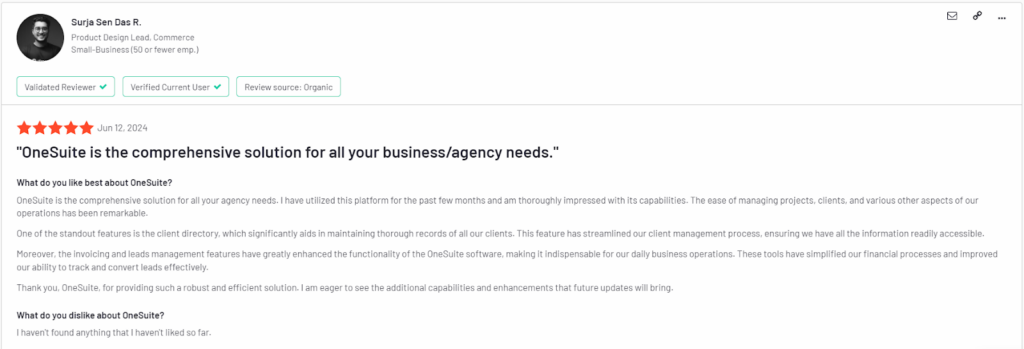
He also points out how OneSuite combines important tools like project management, lead tracking, and invoicing in one place.
Shatveer B. says OneSuite is the best CRM ever because it provides multiple tools like CRM, project management, document management, and invoicing.

He noticed that using OneSuite has helped their team manage full operations in a single platform, making work more efficient.
Shatveer believes OneSuite is a powerful all-in-one solution for businesses, though reducing the cost could make it even better.
Customer Reviews of Bonsai
Let’s dive into some authentic Bonsai reviews

Bernie D., from a small business, calls Bonsai “A must-have for freelance creatives.” He loves how it organizes his business and speeds up client and project management, freeing up time for design work.
While he finds the time tracking a bit clunky, Bonsai significantly streamlines his CRM duties, saving hours on proposals and invoicing.
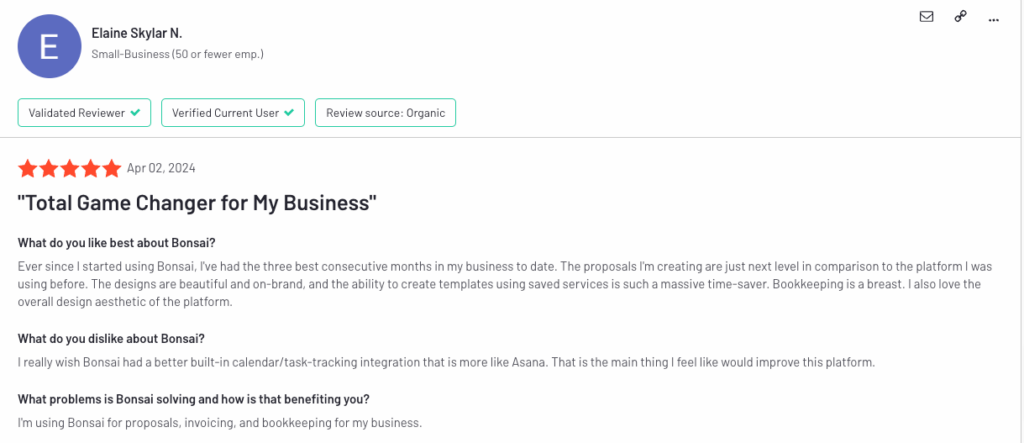
Elaine Skylar N., from a small business, declares Bonsai a “Total Game Changer for My Business.” She credits Bonsai with her best three business months ever, praising its proposal creation, beautiful designs, time-saving templates, and easy bookkeeping.
Her main critique is the need for a better built-in calendar/task-tracking integration, similar to Asana. She uses Bonsai for proposals, invoicing, and bookkeeping.
Which is Best for Agencies, Freelancers, and Teams?
When choosing between OneSuite and Hello Bonsai, it all comes down to how you work and what your business needs.
If you’re running an agency or managing multiple clients and projects, OneSuite gives you the control, flexibility, and tools to scale with ease. Its built-in lead management, client portals, and team collaboration features make it a powerhouse for growing businesses.
For Small Businesses, simplicity is key, and that’s where Hello Bonsai shines. It’s designed for solo professionals who want an easy way to handle contracts, proposals, invoicing, and time tracking—all without getting overwhelmed.
When it comes to teams, OneSuite stands out again. Its strong project management, task assignment, and role customization make it ideal for teams that need to collaborate and grow together.
If you’re building something bigger—an agency, a growing team, or a business that manages multiple projects—OneSuite is the way to go. But if you’re a freelancer who values simplicity and wants to keep things streamlined, Hello Bonsai is your perfect match.
Find a Better Way to Grow
OneSuite streamlines projects, clients, and payments in one place, making growth hassle-free.
